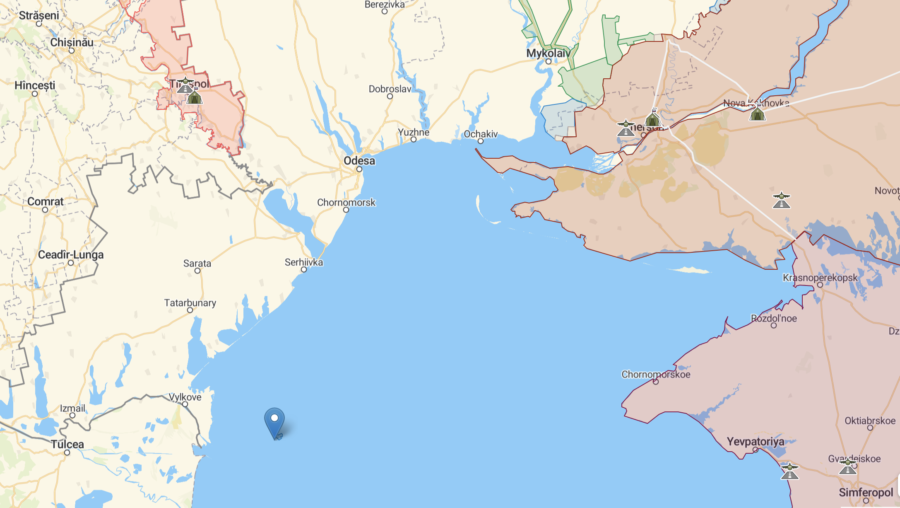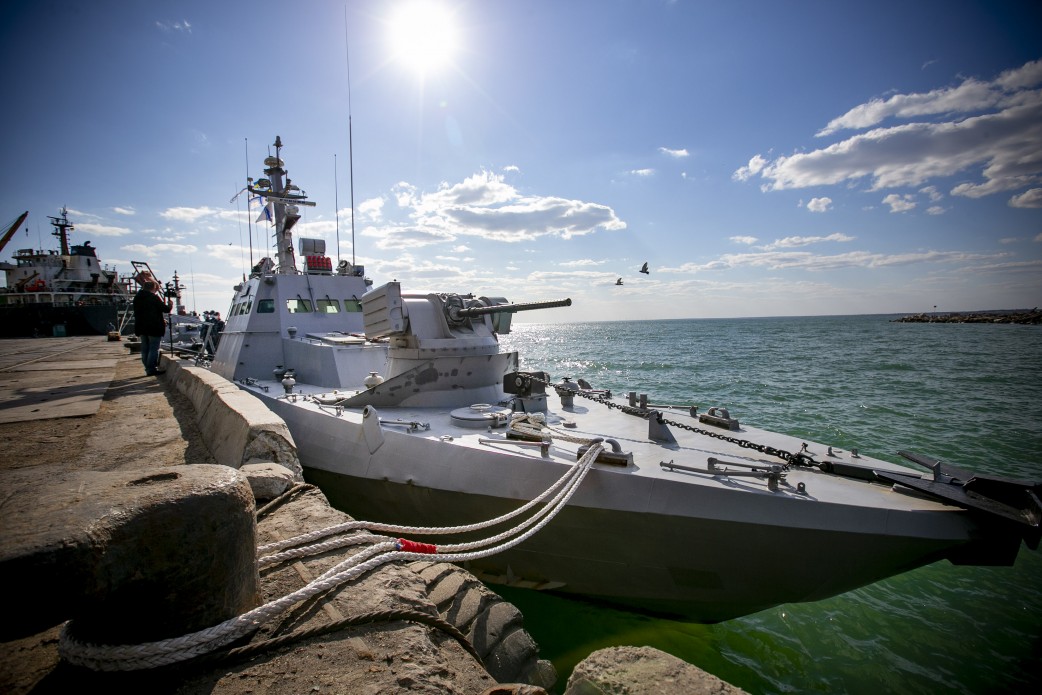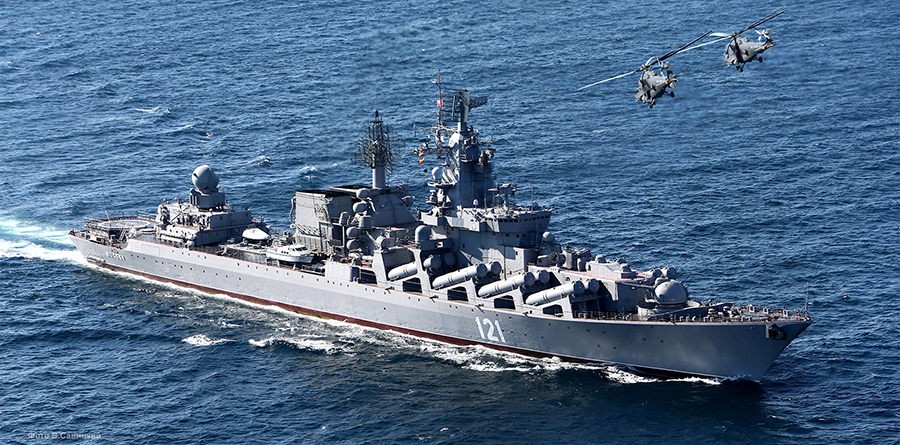Zmiinyi (Snake) Island in the Russia-Ukraine war
Former Ukrainian defense minister Andriy Zahorodnyuk said that Russia used Zmiinyi island and Russian-captured drilling rigs off the Odesa coast to control and blockade maritime shipping, he noted that the Russian grip over Zmiinyi “becomes less critical if we destroy everything that arrives.”
This is what exactly was happening since late April: Ukraine kept on destroying the equipment and troops that Russia tried to deploy on the basically indefensible nearly flat tiny island, which resulted in the Russian retreat from Zmiinyi on 30 June and 1 July.
Moreover, Ukraine had also struck the mentioned rigs on 20 June, forcing Russia to evacuate most of its personnel from them as well.

The contactless battle for Zmiinyi (Snake) Island ends
On 1 July, Valeriy Zaluzhnyi, the Commander-in-Chief of the Ukrainian Armed Forces, reported that the Ukrainian fire made the Russian garrison evacuate from Zmiinyi:
"Unable to withstand the fire of our artillery, missile, and air strikes, the occupiers left Zmiinyi (Snake) Island. I thank the defenders of Odesa, who took maximum measures to liberate this strategically important part of our territory. I bow low to the designers and manufacturers of the Ukrainian self-propelled howitzer Bohdana, which played an essential role in the island's liberation. Thanks to foreign partners for the provided means of destruction."
https://twitter.com/EuromaidanPress/status/1542464258461601792?ew
Ukraine's Operational Command South specified that the Russian troops used two speedboats and left at night while in the morning the island was on fire with detonations heard as a result of Ukraine's missile and artillery barrage.
Later Moscow reported their retreat from Zmiinyi presenting it as an "act of goodwill" that won't allow Kyiv to "speculate" on the topic of grain exports. The Russian propaganda still states that Russia's naval blockade of Ukraine doesn't exist.
On 1 July the Russian defense ministry still claimed full control of the island. Meanwhile, the Commander-in-Chief of the Armed Forces of Ukraine Valeriy Zaluzhnyi reported on Telegram that at about 18:00 a pair of Russian Su-30 that took off from the Bilbek airfield near occupied Simferopol bombed Zmiinyi using "phosphorus bombs." The short footage shared by Zaluzhnyi shows one of the Russian bomb strikes on the island with only one of four bombs hitting the ground and the other three dropping in the water:
Russian army attacked Snake Island
2 Su-30 planes Russian forces conducted two airstrikes using phosphorous bombs from the Bilbek airfield, Commander in Chief of the Armed Forces of Ukraine, Valerii Zaluzhnyi informs https://t.co/IGthnmvq2V pic.twitter.com/9PXfOfF73H
— Euromaidan Press (@EuromaidanPress) July 1, 2022
The Russian bombing of the deserted Zmiinyi might have been attempted in order to destroy the rest of the abandoned Russian equipment left behind by hastily retreating Russian troops and, generally, as a show of force and as a possible premise to the later reported elimination of a Ukrainian non-existent landing party just like the Russian defense ministry claimed several times before.
Adding insult to injury, Zaluzhnyi later shared footage of a Ukrainian Bayraktar TB2 drone striking the abandoned Russian military equipment that sat on a pier on Zmiinyi:
https://twitter.com/EuromaidanPress/status/1543627350268575744
"With yesterday's airstrikes, the Russians tried to destroy their equipment, weapons, and assets on Zmiinyi (Snake) Island. However, they traditionally didn't cope with the task. We 'helped' the invaders to finally evacuate the remnants of their garrison from our island," Zaluzhnyi commented.
Satellite imagery confirmed the date of the Ukrainian strike: on 2 July, a section of the Zmiinyi pier where the attacked Russian equipment sat was missing:
Satellite imagery from @planet from July 1st (left) and July 2nd (right) shows a chunk of the pier missing, exactly where the MRLS were hit. https://t.co/l0rqgbVpnX pic.twitter.com/M2RdmlzQqE
— Eliot Higgins (@EliotHiggins) July 2, 2022
The battle for Zmiinyi island
The strategically important island of Zmiinyi came under Russian occupation on 24 February as the Russian patrol boat Vasily Bykov and the flagship cruiser Moskva approached the island and offered its Ukrainian garrison of border guards to surrender to which the assault party received the now-famous reply by border guard Roman Hrybov, "Russian warship, go f*ck yourself," which became one of the symbols of Ukrainian resistance.
It was the last transmission from the island recorded by Ukraine and the country's leadership believed that the Russians killed the defenders. Yet later it turned out that on the same day, the Russians landed and captured the island and its defenders.
Two days later, the Russian navy seized the Ukrainian civilian search-and-rescue ship Sapphire off Zmiinyi Island.
On 24 March, Ukraine swapped 19 crew members of Sapphire and 10 border guards from Zmiinyi. Earlier, Ukraine said that there were 13 border guards on Zmiinyi in total, while Russia claimed that it had captured 82 Ukrainian soldiers on the island. The fate of the three other border guards and possibly other captured servicemen is unknown as officials didn't mention them later on: those might have been killed in the assault, exchanged later, or still remain in Russian captivity.
The second escalation in the battle for Zmiinyi took place on 13 April, when Ukrainian troops hit the Russian flagship Moskva with two missiles in the island's waters. The Russian flagship sank the next day during an attempted rescue operation. The actual Russian casualties of the loss of Moskva are unknown to this day.
Russian nuclear-capable flagship Moskva sinks after Ukrainian missile strike
On 27 April, the Ukrainian military stated that it had struck Russian military positions on Zmiinyi, destroying the Strela-10 anti-aircraft missile complex. Then on 30 April, according to Ukraine's Operational Command South, a Ukrainian attack on the island destroyed three anti-aircraft guns, the Strela-10 anti-aircraft missile complex, and a communication vehicle.
The next major escalation occurred in early May as on 2-3 May Ukrainian Bayraktar TB2 drones hit the Russian Raptor boats with missiles. Also, Ukraine said that it destroyed two Tor air defense systems.
Ukrainian drone Bayraktar TB2 destroying Russian air defenses on Zmiyinyy Island (also known as Snake or Serpent Island)https://t.co/ADT2dIgaxh pic.twitter.com/tq5eENoSkj
— Euromaidan Press (@EuromaidanPress) May 2, 2022
On 7 May, Ukraine released a video of a Bayraktar TB2 missile attack against a Russian Serna-class landing craft near the island.
A Russian project 11770 Serna-class landing craft has been destroyed in the Black Sea, spokesman for the Odesa Regional Administration Head Serhiy Bratchuk reports.https://t.co/KaylgeMc6S pic.twitter.com/5RUvXmOD8V
— Euromaidan Press (@EuromaidanPress) May 7, 2022
Two Ukrainian Su-27s made a bombing raid on occupied Zmiinyi in early May:
https://twitter.com/UAWeapons/status/1523027490230444035
A Russian Mi-8 helicopter with a landing party was another casualty on Zmiinyi at that period:
#Serpent/Snake/Zmiyinyi Island: Bayraktar vs helicopter pic.twitter.com/FskL78ECHW
— English Luhansk (@loogunda) May 8, 2022
On 17 June, the Ukrainian troops hit the Russian Navy tug Vasily Bekh with two missiles. The tug was on a mission to bring ammunition, weapons, and personnel to Zmiinyi island, and later sank. Among the equipment that it tried to deliver to the island was the Russian aid defense system Tor.
Bayraktar TB2 drone footage showing two Ukrainian missiles hitting the Russian Navy tug Vasily Bekh
Odesa Oblast Head Maksym Marchenko says Harpoon missiles were used, other sources claim it was British-supplied Brimstones.https://t.co/phoN0f5d5T https://t.co/iR7FAGK784 pic.twitter.com/KchWAw0IbK
— Euromaidan Press (@EuromaidanPress) June 17, 2022
On 20 June, Ukraine attacked Zmiinyi and Russian-controlled drilling rigs off the Odesa coast.
On 21 June the Operational Command South reported on a Ukrainian strike on Zmiinyi island, not mentioning any of its results, and two days later the Command said that another Ukrainian attack on Zmiinyi ended up in a hit on the Russian Pantsir-S1 anti-aircraft complex.
On 27 June, Ukraine reported multiple strikes on the island and the destruction of the Russian Pantsir-S1.
On Zmiinyi island, "more than 10 hits were recorded, one of them on another anti-aircraft gun-missile system Pantsir-S1, the rest of the results are being clarified" - 🇺🇦Operational Command Southhttps://t.co/6pTGzF7LBu pic.twitter.com/yesSqKyKhl
— Euromaidan Press (@EuromaidanPress) June 27, 2022
On 29 June, a Russian strike helicopter "got damaged" close to Zmiinyi and fell into the sea, according to Ukraine's South Operational Command, and on the next day, the Command South said that Ukrainian troops destroyed another Russian Pantsir-S1.
The Ukrainian artillery and missile attacks on Zmiinyi intensified, which resulted in the Russian retreat from the island.
Satellite imagery from @Planet shows Snake Island on June 29 compared with imagery from June 30, yesterday.
Looks like all attempts were made to destroy as much as possible during Russia's withdrawal. pic.twitter.com/pEadnvK1ov
— Benjamin Strick (@BenDoBrown) July 1, 2022
Russian equipment lost in battles for Zmiinyi (Snake) Island
The Russian losses of equipment in the battle for Zmiinyi include 7 naval vessels, several pieces of advanced air defense systems, and even at least one multiple-rocket launcher. The most conservative estimations of the Russian losses of equipment in and near Zmiinyi are as follows:
- 1 missile cruiser (flagship Moskva)
- 4 Raptor class boats
- 1 Serna class landing ship
- 1 navy tugboat (Vasily Bekh)
- 3 air defense systems
- 1 Mi-8 helicopter with troops
- 3 Pantsir missile systems
- 1 Strela-10 missile system
- 1 Tornado-G MLRS
Russia not only surrendered Snake Island to Ukraine, but also left behind at least one Pantsir-S1 and radar system.
Such goodwill. pic.twitter.com/8kVVYR07l3
— Oryx (@oryxspioenkop) July 3, 2022
The Russian losses of troops are unknown. Also, Ukraine didn't disclose its losses in the battle of Zmiinyi, although these can't be any high as Ukraine didn't attempt any direct contact with the Russian garrison and mostly used drones, missiles, artillery, and aircraft.
Implications
Zmiinyi Island was the only part of Odesa oblast occupied by Russia, so formally the Russian retreat from the island may be considered the full liberation of the region.
Russia's blockade of all Ukrainian seaports enforced by the Russian Navy has prevented Ukraine from exporting about 6,000,000 tons of grain each month, which threatens starvation in Africa and the Middle East.
Despite the Russian Defense Ministry's official excuse for the retreat from Zmiinyi - a claimed goodwill gesture that will “prevent Kyiv from speculating on the topic of the impending food crisis,” there was no indication that Russia was going to allow safe passage of Ukrainian vessels from Odesa and Mykolaiv ports.
The Russian cruiser Moskva's main role was the air coverage of the Black Sea Fleet given its air defense capabilities. After it was sunk, Russia had to compensate for its loss by deploying a variety of air defense equipment on Zmiinyi, which turned out to be an even easier target for Ukrainian drones, missiles, and later artillery.
Ukrainian MP Oleksii Honcharenko believed that having returned control of the island, Ukraine is going to resume its grain exports "soon."
Yet Serhii Bratchuk, the chief of the Odesa Regional military administration, sees the de-occupation of Zmiinyi as only the first step to de-blockade the Ukrainian ports:
"The liberation of Zmiinyi Island can be considered as the first stage of unblocking Ukrainian ports. There is a difficult road ahead. There is talk, in particular, of humanitarian grain corridors. But considering the fact that we are dealing with a terrorist organization called Russia, the world community still has a lot work to do," he said to Channel 24.
Ukrainian President Volodymyr Zelenskyy said that the liberation of Zmiinyi "already limits the actions of the occupiers significantly. Step by step, we will drive them out of our sea, our land, and our sky."
The Washington-base Institute for the Study of War believes that the Russian retreat from Zmiinyi "will not end the sea blockade, however, as Russian forces have access to land-based anti-ship systems in Crimea and western Kherson Oblast that can still target Ukrainian cargo as well as the use of the remaining ships of the Black Sea Fleet."
Now, Odesa Region Head Bratchuk states that the liberation of Zmiinyi moved the Russian forces to a distance of 100-150 kilometers in the Black Sea.
Read more:
- Russo-Ukrainian War, Day 128: Russian troops flee Zmiiny
- Dealing with the naval blockade of Ukraine: A diversity of views
- Missiles and escorts: Unblocking Ukraine’s ports on the Black Sea
- Russia cancels scheduled Azov Sea blockade, Black Sea still to be blocked (11 February 2022)
- Russia rapidly moving landing ships, submarines of Baltic, Northern & Pacific fleets to Black Sea (2 February 2022)
- Russian hijack of Ukrainian drilling rigs could open hybrid naval blockade (2015)




